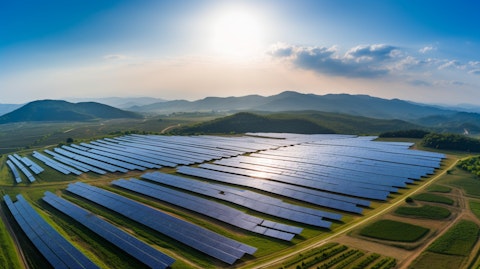In this article, we look at the 7 Best Alternative Fuel Stocks To Buy Right Now.
The Future of Alternative Fuels
The alternative fuel and renewable energy industry is currently one of the most prominent sectors globally. Examples of alternative or renewable fuels include wind, solar, hydropower, and biofuel energy. According to the Business Research Company, the global alternative fuel or renewable energy market was valued at $1.10 trillion in 2024 and is projected to reach $1.55 trillion by 2028, growing at a CAGR of 8.8%. The growing environmental concerns and strict environmental regulations in many developed countries have significantly boosted the renewable energy sector and the energy generation market has seen an increase in installed capacity for renewable sources. The increasing power demand and energy consumption are also the key reasons for the growing demand in the alternative or renewable fuels industry.
According to the International Energy Agency (IEA), the global energy demand will increase by 3.4% annually by 2026, 85% of this additional demand is expected to come from China and India, with India’s electricity demand alone predicted to grow by over 6% annually until 2026 due to economic growth and rising air conditioning use. Southeast Asia is also expected to see a 5% annual increase in electricity demand through 2026. In the United States, a moderate rise in electricity demand is anticipated in the coming years, primarily driven by data centers. The electricity consumption by data centers, artificial intelligence, and cryptocurrency could potentially double to 1,000 TWh by 2026. IEA forecasts that the surge in electricity generation from low-emission sources will meet global demand growth over the next three years, with renewable energy expected to surpass coal as the leading energy source by early 2025.
The U.S. Energy Information Administration (EIA) anticipates a 17% growth in renewable energy deployment in 2024, potentially reaching 42 GW and contributing to nearly a quarter of the nation’s electricity generation. However, this growth may be accompanied by a temporary rise in renewable energy costs due to high financing, labor, and land expenses. However, tax credits from the Inflation Reduction Act (IRA) and Infrastructure Investment and Jobs Act (IIJA) are expected to sustain the competitiveness of solar and wind energy. Solar and storage markets are expected to expand further due to tax incentives and government support, particularly through programs like the DOE’s Loans Program Office. However, the wind and hydrogen energy sector may face challenges. Wind energy is facing challenges due to higher deployment costs and delays in getting approval, while hydrogen energy is struggling due to a lack of government incentive programs to support it.
Investing in a Greener Future
In a recent interview, Bruce Flatt, CEO of Brookfield Asset Management, emphasized that the decarbonization of the world is a major trend reshaping industries and investments. The company has established a dedicated renewable energy fund, initially raising $15 billion and planning to raise a second fund, that aims to support companies in reducing their carbon emissions by investing in and developing renewable energy projects. Flatt highlighted that they are one of the largest global builders and owners of renewable energy assets, including solar and wind power projects across 15 countries. The company’s approach involves not only building renewable energy infrastructure but also directly supplying renewable power to corporate clients, which helps these companies meet their net-zero commitments. The U.S. Inflation Reduction Act (IRA) has had a positive impact on the renewable energy sector. The IRA has provided substantial incentives for renewable energy projects, which has accelerated the pace of development. Flatt pointed out that the Act has increased the likelihood of projects being completed, with more projects moving forward in less time, which is beneficial to the renewable energy market. He mentioned that they target returns of approximately 9-10% for debt products and around 20% for equity investments in the renewable sector. Flatt is optimistic that returns will improve as the sector continues to grow and attract more capital.
Hanchen Wang, Equity Analyst at DWS Group, is optimistic about the renewables market’s future and believes that the market is becoming increasingly attractive to investors due to the long-term potential for stable returns and the alignment with global sustainability goals. Wang highlights that while renewable energy sources like wind, solar, and hydropower are expanding their market share, they are still facing challenges such as high initial costs and intermittency issues. He points out that advancements in technology, such as improved energy storage solutions and grid infrastructure, are critical to addressing these challenges and supporting the sector’s growth.
The alternative fuel and renewable energy industry is expected to grow significantly due to growing environmental awareness, supportive regulations, and technological advancements in alternative fuels like wind, solar, and hydropower. Despite facing challenges such as high initial costs and technological hurdles, the sector’s trajectory remains positive, driven by strong global demand and substantial investment opportunities. With that in context, let’s look at the 7 best alternative fuel stocks to buy right now.

An aerial view of a solar power plant, the sun’s rays illuminating the surrounding landscape.
Our Methodology
For this article, we used Clean Energy ETFs plus online rankings to compile an initial list of 40 alternative fuel stocks. From that list, we narrowed our choices to 7 stocks according to their hedge fund sentiment, which was taken from our database of 912 elite hedge funds as of Q2 of 2024. We also included the market cap of these companies as of August 20. The list is sorted in ascending order of their hedge fund sentiment, as of June 30.
Why do we care about what hedge funds do? The reason is simple: our research has shown that we can outperform the market by imitating the top stock picks of the best hedge funds. Our quarterly newsletter’s strategy selects 14 small-cap and large-cap stocks every quarter and has returned 275% since May 2014, beating its benchmark by 150 percentage points (see more details here).
7 Best Alternative Fuel Stocks To Buy Right Now
7. Sunrun (NASDAQ:RUN)
Number of Hedge Fund Holders: 36
Market Capitalization as of August 20: $4.31 Billion
Sunrun (NASDAQ:RUN) is a residential solar energy provider in the United States. The company offers solar-as-a-service solutions that allow homeowners to adopt solar power with little to no upfront cost. Sunrun’s (NASDAQ:RUN) portfolio of residential solar installations positions it well to benefit from increased demand for clean energy solutions.
In Q2 2024, Sunrun (NASDAQ:RUN) reported revenue of $523.87 million, which is a 6.98% increase year-over-year and a 14.33% increase compared to the previous quarter. The company achieved a net income of $139.07 million for the quarter, a significant 113% increase year-over-year and 258.37% compared to the previous quarter. This resulted in earnings per share (EPS) of $0.55, a 115.92% increase year-over-year and a 236.5% improvement from the last quarter.
Sunrun’s (NASDAQ:RUN) net profit margin also saw a significant improvement, reaching 26.55%, a 179.75% rise compared to the same period last year. The debt-to-equity ratio increased to 2.25, up 48.77% year-over-year, indicating rising financial leverage.
However, analysts project a significant improvement in Sunrun’s (NASDAQ:RUN) earnings performance, expecting the EPS to increase to -$0.25 by the end of this year, suggesting optimism about the company’s future profitability and financial stability. The company has been investing in its infrastructure and technology, which could enhance its margins and profitability as the company scales its operations and optimizes its business model.
The recent stock gains reflect investor belief in Sunrun’s (NASDAQ:RUN) future potential. If the company successfully executes its growth strategy and improves its financial health, the stock could benefit from a significant rebound. Sunrun (NASDAQ:RUN) has a market cap of $4.31 billion as of August 20. As of the second quarter, the stock is held by 36 hedge funds with stakes worth $694.88 million. Orbis Investment Management is the largest shareholder in the company and has stocks worth $164.80 million as of June 30.
6. Clearway Energy (NYSE:CWEN)
Number of Hedge Fund Holders: 38
Market Capitalization as of August 20: $5.71 Billion
Clearway Energy (NYSE:CWEN) is an energy company that operates a diverse portfolio of wind and solar projects as well as conventional power generation assets across the United States. Global Infrastructure Partners (GIP), an independent infrastructure investment fund, and TotalEnergies (EPA:TTE), a major multinational energy and petroleum company have collaborated on projects with Clearway Energy (NYSE:CWEN) to leverage its expertise in renewable energy capabilities in the U.S.
Clearway Energy (NYSE:CWEN) is working on several large-scale renewable energy projects in California such as Luna Valley and Daggett I which are expected to be operational by 2025. The Luna Valley Solar Project is a 200 MW solar initiative located in Fresno County, once completed, it will generate enough electricity to power over 80,000 homes annually. Whereas, the Daggett Storage I Project is a 113.5 MW battery energy storage facility in San Bernardino County which is a 482 MW solar and 280 MW energy storage. These projects are backed by long-term contracts by investment-grade entities and are expected to generate significant earnings for the company.
The company’s diversified portfolio and strategic focus on renewable energy assets position it to capitalize on the ongoing global energy transition trends and offer long-term growth potential. Clearway Energy (NYSE:CWEN) has a market cap of $5.71 billion as of August 20. As of the second quarter, the stock is held by 38 hedge funds with stakes worth $139.80 million. Point72 Asset Management is the largest shareholder in the company and has stocks worth $25.10 million as of June 30.
5. Enphase Energy (NASDAQ:ENPH)
Number of Hedge Fund Holders: 42
Market Capitalization as of August 20: $15.89 Billion
Enphase Energy (NASDAQ:ENPH) is a global energy technology company specializing in solar microinverters, energy management technology, and energy storage solutions. The company’s solar microinverters convert direct current (DC) electricity from solar panels into alternating current (AC) for use in homes and businesses. Enphase Energy’s (NASDAQ:ENPH) products are critical for optimizing solar energy systems and enhancing efficiency. Enphase Energy (NASDAQ:ENPH) has established itself as a market leader in residential solar in the U.S., Europe, and emerging markets in Asia.
Enphase Energy (NASDAQ: ENPH) reported mixed results for Q2 2024, with revenue and earnings slightly below expectations due to low sales in Europe. However, the company maintained a gross margin of 47.1%, surpassing consensus expectations. The company’s microinverter technology remains a top choice among consumers, and its growing presence in Europe suggests that it is successfully capturing market share from rivals. Moreover, the transition to the new net metering policy “Net Energy Metering 3.0” in California which incentivizes homeowners to use their own solar energy rather than selling excess energy back to the grid, has led to a significant increase in its energy storage systems that further boosted the company’s revenue. The company reported a 32% increase in U.S. revenue in Q2 2024. For Q3 2024, almost 85% of the products are already booked by orders.
Enphase Energy (NASDAQ:ENPH) is well positioned to benefit from the U.S. Inflation Reduction Act (IRA) through its domestic production capabilities. The company’s microinverters can help customers qualify for a 10% Investment Tax Credit (ITC) bonus under the Domestic Content Bonus Credit provisions of the Inflation Reduction Act which is available for solar projects that utilize a certain percentage of U.S.-made components, including microinverters. This strategic advantage is expected to drive market share gains and enhance gross margins, particularly in Q4 2024.
The company’s recent product launches, including new microinverters, energy management software, and battery storage solutions, are expected to drive future growth. Additionally, the company’s growing presence in Asia and European markets will further support its growth trajectory. Industry analysts have a consensus on the stock’s Buy rating, setting an average share price target at $126.17, which represents a 7.55% upside potential from its current level. The company is valued at $15.89 billion as of August 20. As of the second quarter, the stock is held by 42 hedge funds with stakes worth $505.91 million. Citadel Investment Group is the largest shareholder in the company and has stocks worth $141.66 million as of June 30.
4. First Solar (NASDAQ:FSLR)
Number of Hedge Fund Holders: 66
Market Capitalization as of August 20: $23.96 Billion
First Solar (NASDAQ:FSLR) plays a pivotal role in the solar industry and is a leading global supplier of photovoltaic (PV) solar energy solutions in the US. The company manufactures solar panels and develops large-scale solar power plants that use cutting-edge thin-film solar technology. First Solar (NASDAQ:FSLR) also has operations in Malaysia and Vietnam.
In Q2 2024, First Solar (NASDAQ:FSLR) reported revenues of $1.01 billion, marking a 24.7% year-over-year increase, alongside a significant 95% year-over-year rise in adjusted EBITDA to $470 million. These figures were supported by higher module selling prices and improved gross margins, which reached an impressive 49.4%, significantly outpacing expectations.
First Solar’s (NASDAQ:FSLR) products are high in demand and the company has an order backlog extending through 2030. The company is expanding its production capacity and recently completed its Ohio plant expansion. First Solar (NASDAQ:FSLR) is constructing new facilities in Alabama and Louisiana which are expected to nearly double the company’s production capacity in the U.S. and will position the company to meet the growing demand for solar energy domestically.
First Solar (NASDAQ:FSLR) is currently in the process of patenting its TOPCon technology which aims to enhance the efficiency of solar panels. The royalties from the patent could also provide an additional revenue stream, which will further strengthen the company’s financial position. The company is expected to grow its earnings by almost 55% this year. Industry analysts have a consensus on the stock’s Buy rating, setting an average share price target at $292.22, which represents a 28% upside potential from its current level.
The company has positioned itself as a key beneficiary of the growing demand for clean energy solutions. The company is valued at $23.96 billion as of August 20. As of the second quarter, the stock is held by 66 hedge funds with stakes worth $1.68 billion. Citadel Investment Group is the largest shareholder in the company and has stocks worth $766.56 million as of June 30.
3. Constellation Energy (NASDAQ:CEG)
Number of Hedge Fund Holders: 71
Market Capitalization as of August 20: $59.48 Billion
Constellation Energy (NASDAQ:CEG) is a supplier of power, natural gas, and energy products and services. The company serves a diverse range of customers, including residential, commercial, and industrial clients across North America. Constellation Energy (NASDAQ:CEG) is a major player in the renewable energy sector, particularly in nuclear power, and is committed to delivering clean and affordable energy. Constellation Energy (NASDAQ:CEG) is a leader in carbon-free energy and contributes 10% of the carbon-free energy consumed in the United States.
The company’s financial performance and strategic investments in clean energy solutions make it a compelling long-term investment. In Q1 2024, Constellation Energy’s (NASDAQ:CEG) net income per share increased from $0.29 in Q1 2023 to $2.78 in Q1 2024, while adjusted operating earnings doubled from $0.78 to $1.82. The company plans to buy back $1.5 billion worth of shares, which reflects management’s confidence in the company’s long-term prospects. The company is expected to grow its earnings by 45.84% this year. Industry analysts have a consensus on the stock’s Buy rating, setting an average share price target at $225.03, which represents a 16% upside potential from its current level.
Constellation Energy (NASDAQ:CEG) also plans to expand its clean energy portfolio and issued a $900 million, 30-year corporate green bond for initiatives such as nuclear upgrades, clean hydrogen production, and energy storage systems, which are crucial for increasing the production of clean, carbon-free energy. Major tech players such as Google, Microsoft, and Nucor Steel, have a long-term contract for the purchase of sustainable energy with Constellation Energy (NASDAQ:CEG), which will provide a stable, long-term revenue stream for the company. The company plans to invest $800 million in upgrading equipment at its Braidwood and Byron plants in Illinois which is expected to boost energy output by 158 megawatts. Additionally, the repowering of the Criterion wind project in Maryland will increase clean energy production by 79,000 megawatt-hours (MWh).
In its second quarter investor letter, ClearBridge stated the following regarding Constellation Energy (NASDAQ:CEG):
“On a regional basis, the U.S. and Canada was the top contributor for quarter, with U.S. electric utility Constellation Energy Corporation (NASDAQ:CEG) and U.S. rail operator CSX the lead performers. Constellation Energy is primarily a nuclear generation company and is the largest producer of carbon-free electricity in the U.S., serving states including New York, Illinois, Maryland, Pennsylvania and New Jersey. The company’s combined generation capacity is more than 32 GW and 90% of annual output is carbon free. Constellation has been a beneficiary of AI and subsequent power demand as its 24/7 base load nuclear generation can get premium contracts.”
Constellation Energy’s (NASDAQ:CEG) financial performance, leadership in carbon-free energy production, strategic partnerships, and ongoing investments in clean energy infrastructure provide a solid foundation for long-term growth. Constellation Energy (NASDAQ:CEG) is a compelling investment for those with a long-term perspective. The company is valued at $59.48 billion as of August 20. As of the second quarter, the stock is held by 71 hedge funds with stakes worth $3.78 billion. Coatue Management is the largest shareholder in the company and has stocks worth $982.90 million as of June 30.
2. NextEra Energy (NYSE:NEE)
Number of Hedge Fund Holders: 81
Market Capitalization as of August 20: $163.56 Billion
NextEra Energy (NYSE:NEE) operations are divided into two main businesses. The first is Florida Power & Light (FPL) which is the largest electric utility company in Florida and one of the largest in the United States. The second major business is NextEra Energy Resources (NEER) which is the world’s largest producer of renewable energy from wind and solar and is a global leader in battery storage. NEER focuses on developing, constructing, and operating long-term contracted assets primarily in the United States and Canada.
The company has over 20 years of experience in developing and operating several renewable projects and has a significant competitive edge over newer entrants. This expertise has enabled NEER to capture a substantial market share, holding 56% of the wind market in 2022 and 38% of the renewable market share from 2019 to 2022. As of 2023, NEER has a clean energy portfolio of around 34 GW of operational capacity, comprising 24 GW of wind energy, 7 GW of solar energy, 2 GW of nuclear energy, and 1 GW of battery storage spanning across 16 states in the U.S.
Almost 93% of NEER’s revenues are secured through long-term Power Purchase Agreements with major customers including data centers and technology companies which provide stable and predictable cash flows for the company. NEER’s financial performance is strong, with adjusted earnings growing by 10.8% in Q2 2024 due to new investments and an expanding renewables portfolio. Looking ahead, the company expects its earnings per share (EPS) to grow by 6-8% each year until 2027 and plans to increase its dividend payments by 10% each year.
In its second quarter investor letter, ClearBridge stated the following regarding NextEra Energy (NYSE:NEE):
“AI-related momentum was a key driver of performance in the second quarter, lifting the enablers in technology as well as holdings like renewable power producer NextEra Energy, Inc. (NYSE:NEE) that supply the increasing energy needs of data centers. Parts of the market lacking an AI connection, like our medical device holdings, underperformed despite no change to fundamentals. We have managed through several similar momentum periods over our tenure and have delivered long-term results for shareholders by staying true to an approach that emphasizes diversification across three buckets of growth companies (select, stable and cyclical) and seeks to take advantage of attractive entry points into quality growth businesses.”
NextEra Energy’s (NYSE:NEE) renewable business is poised for continuous growth due to its dominant position, strong financials, and strategic position. As of August 20, the company is valued at $163.56 billion. As of the second quarter, NextEra Energy’s (NYSE:NEE) stock is held by 81 hedge funds with stakes worth $2.10 billion. GQG Partners is the largest shareholder in the company and has stocks worth $884.56 million as of June 30.
1. Vistra (NYSE:VST)
Number of Hedge Fund Holders: 93
Market Capitalization as of August 20: $28.27 Billion
Vistra (NYSE:VST) is involved in electricity generation, wholesale energy sales, commodity risk management, fuel production, and logistics. The company was founded in 1882 and sells electricity and natural gas to residential, commercial, and industrial customers. Vistra (NYSE:VST) operates battery energy storage facilities and a diversified energy portfolio that produces approximately 41,000 megawatts using natural gas, coal, nuclear, and solar.
For the quarter ended on June 30, Vistra (NYSE:VST) reported a mixed performance. The company reported a net income of $467 million, slightly lower than the $476 million recorded in the same period in 2023. However, the company’s ongoing operations net income, which reflects its core business activities, improved significantly, rising to $492 million from $409 million in 2023. Additionally, ongoing operations Adjusted EBITDA, a key measure of profitability, showed strong growth, increasing by 40% to $1.41 billion compared to $1.0 billion in the same period last year. This suggests that the company’s business performance has strengthened, despite the slight decline in overall net income.
Vistra’s (NYSE:VST) stock surged by almost 175% over the last 12 months. This remarkable growth can be attributed to the company’s strategic positioning in the energy market, driven by the growing demand for power, especially from AI and data centers. The company’s recent acquisition of Energy Harbor expanded its nuclear capabilities and has been a significant catalyst to position the company as a leader in clean and reliable energy. The company is expected to grow its earnings by 40% this year. Industry analysts have a consensus on the stock’s Buy rating, setting an average share price target at $110.26, which represents approximately 30% upside potential from its current level.
Vistra’s (NYSE:VST) involvement with AI goes beyond just supplying power, the company has also implemented AI technologies within its operations to enhance the efficiency of its power plants, improve thermal efficiency, and reduce carbon emissions. An example of this is the Heat Rate Optimizer (HRO), an AI initiative that has helped the company save millions in operational costs. This makes Vistra (NYSE:VST) an attractive choice for data centers that require reliable and clean energy sources.
In the second quarter 2024 investor letter, Legacy Ridge Capital stated the following remarks regarding Vistra (NYSE:VST):
“One of the sectors we know well which had been out of favor for several years has quickly come into favor: Independent Power Producers (IPPs). We’ve written consistently about NRG and Vistra Corp. (NYSE:VST) since the 2019 letter, have owned each, or both, since 2018, and invested a meaningful amount of our assets in VST specifically the past few years. Nate and I intend on spending more time in the year-end letter on our updated views on the IPPs and our learnings from the on-going investment, but we were a bit surprised how quickly the narrative around these companies changed. Our Blue Sky 2030 estimates of intrinsic value converged with the share price 6-years before we thought probable.”
Vistra’s (NYSE:VST) strategic investments in clean energy, its ability to leverage AI and capitalize on market dynamics present a compelling investment opportunity for investors looking to benefit from the ongoing energy transition. Vistra (NYSE:VST) has a market cap of $28.27 billion as of August 20. As of the second quarter, the stock is held by 93 hedge funds with stakes worth $4.03 billion. Lone Pine Capital is the largest shareholder in the company and has stocks worth $587.93 million as of June 30.
While we acknowledge the potential of Vistra (NYSE:VST) to grow, our conviction lies in the belief that AI stocks hold greater promise for delivering higher returns and doing so within a shorter timeframe. If you are looking for an AI stock that is more promising than VST but that trades at less than 5 times its earnings, check out our report about the cheapest AI stock.
READ NEXT: $30 Trillion Opportunity: 15 Best Humanoid Robot Stocks to Buy According to Morgan Stanley and Jim Cramer Says NVIDIA ‘Has Become A Wasteland’.
Disclosure. None. Insider Monkey focuses on uncovering the best investment ideas of hedge funds and investors. Please subscribe to our daily free newsletter to get the latest investment ideas from hedge funds’ investor letters by entering your email address below.





